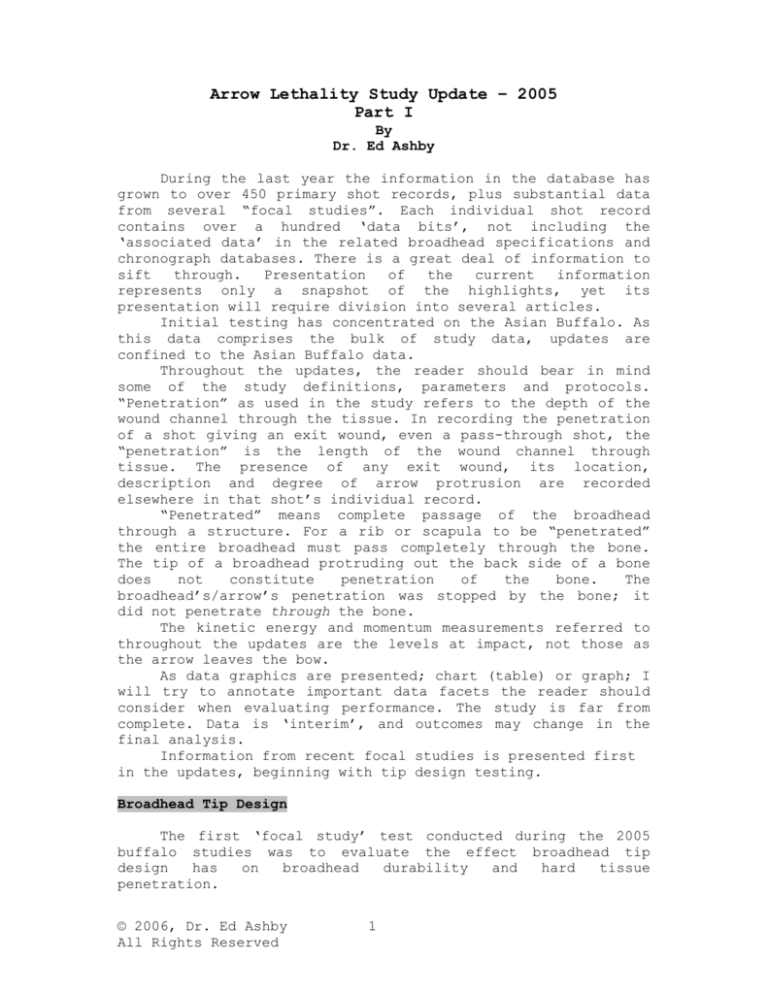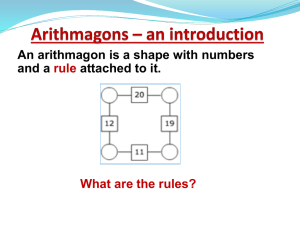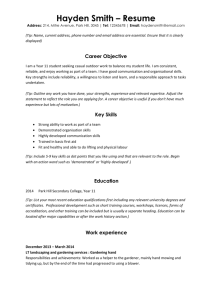
Arrow Lethality Study Update – 2005
Part I
By
Dr. Ed Ashby
During the last year the information in the database has
grown to over 450 primary shot records, plus substantial data
from several “focal studies”. Each individual shot record
contains over a hundred ‘data bits’, not including the
‘associated data’ in the related broadhead specifications and
chronograph databases. There is a great deal of information to
sift
through.
Presentation
of
the
current
information
represents only a snapshot of the highlights, yet its
presentation will require division into several articles.
Initial testing has concentrated on the Asian Buffalo. As
this data comprises the bulk of study data, updates are
confined to the Asian Buffalo data.
Throughout the updates, the reader should bear in mind
some of the study definitions, parameters and protocols.
“Penetration” as used in the study refers to the depth of the
wound channel through the tissue. In recording the penetration
of a shot giving an exit wound, even a pass-through shot, the
“penetration” is the length of the wound channel through
tissue. The presence of any exit wound, its location,
description and degree of arrow protrusion are recorded
elsewhere in that shot’s individual record.
“Penetrated” means complete passage of the broadhead
through a structure. For a rib or scapula to be “penetrated”
the entire broadhead must pass completely through the bone.
The tip of a broadhead protruding out the back side of a bone
does
not
constitute
penetration
of
the
bone.
The
broadhead’s/arrow’s penetration was stopped by the bone; it
did not penetrate through the bone.
The kinetic energy and momentum measurements referred to
throughout the updates are the levels at impact, not those as
the arrow leaves the bow.
As data graphics are presented; chart (table) or graph; I
will try to annotate important data facets the reader should
consider when evaluating performance. The study is far from
complete. Data is ‘interim’, and outcomes may change in the
final analysis.
Information from recent focal studies is presented first
in the updates, beginning with tip design testing.
Broadhead Tip Design
The first ‘focal study’ test conducted during the 2005
buffalo studies was to evaluate the effect broadhead tip
design
has
on
broadhead
durability
and
hard
tissue
penetration.
© 2006, Dr. Ed Ashby
All Rights Reserved
1
The broadheads used were Tusker Concords. The Concord is
a 155 gr. broadhead with a long and narrow profile, having a
1.115” cut width and a cut edge length of 2.651”. In earlier
buffalo test it had shown a tendency to bend frequently,
especially with adverse angle bone impact.
Forty-two of these broadheads were used for testing; six
each of seven different tip profiles. Six of the heads
retained the factory needle tip. Six were modified to each of
the following tip profiles: flat (squared off at the tip);
chisel (squared off and sharpened to a cut-on-impact (COI)
edge); COI arch; COI round tip; COI Tanto tip and COI concave
tip.
Broadhead edges were sharpened with a double bevel of 25
degrees, for a 500 total sharpening angle, with edges honed and
stropped to a true shaving edge. All were mounted on tapered
hickory shafts. Shaft/broadhead combinations were matched to
give no more than plus or minus 7.5 grains maximum variation
in total mass. Both the average and median arrow mass was 771
grains. To facilitate placing all impacts on the scapular
flats, shooting was done at a range of 10 yards.
All shots were with a longbow of 70# draw weight. Average
impact momentum (Mo) for the test arrows was 0.442 SlugFt/Second. Average impact kinetic energy (KE) was 28.48 ft.lbs. The low impact force was chosen so that most of the
broadheads would be unlikely to penetrate the scapula flat.
Testing was conducted on two freshly culled buffalo; a
young adult male and an adult female. Three shots were fired
with each tip design into the scapular flats of each buffalo.
All shots into the young male were fired from a broadside
position, with arrows striking perpendicular to the bone’s
surface. All shots into the adult female buffalo were fired
quartering from the front, giving a sharply oblique 400 angle
of impact on the bone.
Chart 1 shows the test results. Test numbers are fairly
low, but indicate a clearly defined tendency. Even at low
impact force, COI tips having round or Tanto profiles show a
marked increase in frequency of bone penetration and a low
frequency of damage. No broadhead with a flat, chisel or
concave configuration penetrated the scapular flat. Needle
tipped broadheads had a low frequency of penetrating the
scapula, and a 100% bend rate.
The arch profile faired only slightly better than the
flat, chisel and concave. Durability of the Tanto profile was
of no surprise. In all prior testing no tip of Tanto profile
has suffered damage.
Numerous queries have been received asking, “What is a
Tanto tip, and what does it look like?” The term “Tanto tip”
is one I coined over a quarter century ago, and chosen merely
because the profile reminded me of two Tanto knives placed
back to back.
© 2006, Dr. Ed Ashby
All Rights Reserved
2
Accompanying photos should clarify what a ‘Tanto tip’
looks like. “Tanto tip” is a profile, and can be applied in
any width; ergo, one can have a “narrow Tanto tip” or “wide
Tanto tip”; a “COI Tanto tip”, such as I change the Grizzly’s
factory tip to, or a non-COI Tanto tip, such as the Grizzly’s
factory tip.
After conducting these tip design test, a number of
broadheads previously demonstrating a tendency for tips to
break or bend were modified to a COI Tanto profile. In tests
subsequent to these modifications no incidences of tip damage
were encountered.
It should be noted that broadheads selected for tip
modification were those that had shown good blade strength,
edge retention, and steel quality, but with a frequent
tendency to bend/break in the area of the tip. This
encompassed the Abowyer Custom; Eclipse; STOS; Wolverine;
Magnus II; and Zwickey. The BlackStump was added to this list
mid-way through this year’s testing.
Edge Bevels
After the examination of hundreds of shots penetrating
through bone, by a multitude of different broadheads, a
consistent difference was noted between single and double
bevel broadheads in the frequency of bone splits.
In the bone-split photos accompanying, note the long
splits in the buffalo rib bones caused by the single bevel
Grizzly. These are a normal occurrence, but frequently are not
easily visible until the bone is thoroughly cleaned and/or
dried. Commonly these splits extend 4” to 6” from the point of
blade entry into the bone. Clearly visible in the photos is
the “S” shaped hole created as the single bevel broadhead
rotates while passing through the bone, as opposed to a
straight cut created by the double bevel broadhead. The double
cut broadhead hole in the photo is from a Deadhead.
It is theorized that the torque force applied by the
broadhead’s rotation causes the bone to be ‘popped apart’.
This splitting of bone shows a higher frequency on ribs and
long bones (humerus, femur) than on flat bones (scapula), but
is common in both. It is plausible speculation that a single
bevel broadhead may tap into the arrow’s rotational energy
during this penetration, achieving useful work from arrow
energy generally not gainfully employed in penetration.
The splitting of bone, as opposed to cutting a blade-size
hole through it, is a desirable feature in broadhead design.
The measurable penetration difference indicates that it
permits easier passage through the bone, reducing arrow drag
and increasing overall penetration.
A series of focal studies was conducted to test the
effect of the type of edge bevel on penetration when bone is
encountered. Thanks to Ben Pearson Jr. I was able to secure
© 2006, Dr. Ed Ashby
All Rights Reserved
3
some Deadhead blanks that had never had an edge bevel applied.
On these I applied a 250 right hand single bevel (250 total
edge angle). These were used as a comparison to Deadheads
having a 250 double bevel edge finish (500 total edge angle).
Alan Woodward, maker of the Outback Broadheads supplied
several samples of his broadheads; some with a right hand
single bevel; some a left hand single bevel; and some with
double bevel. Several samples of each edge bevel type were
supplied
in
both
long-narrow
and
short-wide
broadhead
configurations. The single bevels were also set at 250 (for a
total edge angle of 500).
Chart 2 shows the comparative results from testing the
single and double bevel Deadheads. Chart 3 reflects results
with the experimental Outback broadheads.
All shots were taken from a broadside shooting angle at
20 yards. Each shot series were fired in matched sets so that
equality between test subjects and edge types tested was
maintained. The Deadheads were tested on tapered hickory
shafts from a 70# longbow. The Outback’s testing was with
aluminum shafting and a 65# Compound.
On shots impacting a rib the single bevel Deadheads show
a 31% increase in average penetration over the double bevel
Deadheads. When the scapula is hit the single bevels show a
40% increase in penetration.
The Outback broadheads were used only on rib shots. The
narrow single bevels show an increase in penetration of 58%
over those with double bevels. Wide cut single bevels show a
49% increase in penetration.
Two shots each were taken with a narrow and a wide cut
left hand single bevel mounted on a right fletched shaft. This
created a situation where the direction of rotation caused by
the broadhead’s bevel is opposite the direction of arrow
rotation in flight. These show a decrease in penetration from
the corresponding right hand beveled samples of 42% and 67%,
respectively. With single bevel heads it is important that the
direction of arrow rotation in flight match the direction of
rotation caused by the blade’s bevel.
While this is fairly limited sampling, comprising only 45
shots, the findings were consistent, with three broadheads of
vastly differing profiles. They represent a coherent tendency;
with both the average penetration and the median penetration
showing a clear advantage for single bevel broadheads in
penetrating through bone. This is strongly suggestive that
single
bevel
broadheads
offer
a
marked
advantage
in
penetration through bone.
© 2006, Dr. Ed Ashby
All Rights Reserved
4
Chart 1
Broadhead Tip Design Test
NTotal=42
Test Broadheads: Modified Concord.
For all shots: Arrow Mass = 771 Gr. + 7.5 gr.; Impact Momentum = 0.442; Impact
KE = 28.48
Six shots with each tip design:
3 shots, each tip design, at approx. 400 quartering from the front on an adult
female Asian Buffalo;
3 shots, each tip design, from
broadside on a young adult male Asian Buffalo.
All Impacts: Scapular Flat
Range: 10 yards.
N=
6
6
6
6
6
6
6
Tip
Design
Tanto
Round
Chisel
Arch
Concave
Needle
Flat
Number
Pen.
Scapular
Flat
5
4
0
1
0
1
0
Number
Broadheads
Damaged
1
2
2
3
0
6
2
Average
Penetration
(Inches)
9.73
7.63
6.00
5.63
4.63
5.33
5.42
Range Of
Penetration
(Inches)
6.4 - 12.1
5.0 - 10.1
5.5 - 6.6
5.0 - 7.1
4.5 - 5.0
4.9 - 6.1
4.8 - 6.4
Median
Penetration
(Inches)
9.07
7.75
5.94
6.06
4.50
5.00
5.06
Chart 2
Deadhead Bevel Test
NTotal = 20
N=
Deadheads
Avg.
Mass
Average
Impact
Kinetic
Energy
Average
Impact
Momentum
Average
Penetration
(Inches)
Penetration
Range
(Inches)
Median
Penetration
(Inches)
5
Double Bevel:
Scapula Impact
770
31.62
0.46
7.75
5.9 - 7.6
7.25
5
Single Bevel:
Scapula Impact
770
31.62
0.46
9.85
5.4 - 12.1
10.25
5
Double Bevel:
Rib Impact
770
31.62
0.46
12.03
2.8 - 20.0
13.875
5
Single Bevel:
Rib Impact
770
31.62
0.46
18.03
14.9 - 22.9
18.125
© 2006, Dr. Ed Ashby
All Rights Reserved
5
Chart 3
Experimental Outback Test
NTotal = 25
N=
Exp. Outback
(Rib Impact)
Avg.
Mass
Average
Impact
Kinetic
Energy
8
*Narrow Cut
Double Bevel
684
44.58
0.52
12.75
9.8 - 11.6
11.63
5
Narrow Cut
Single Bevel
662
43.99
0.51
17.63
14.5 - 19.25
18.125
4
Wide Cut
Double Bevel
660
43.85
0.51
10.59
7.0 - 15.3
10.06
4
Wide Cut
Single Bevel
660
43.85
0.51
14.28
12.0 - 15.3
14.94
2
Left Narrow Cut
Single Bevel
Right Fletch
662
43.99
0.51
10.75
8.0 - 13.5
10.5
2
Left Wide Cut
Single Bevel
Right Fletch
660
43.85
0.51
4.94
4.9 – 5
4.96
•
Average
Impact
Momentum
Average
Penetration
(Inches)
Penetration
Range
(Inches)
Median
Penetration
(Inches)
Includes 3 shots with a prototype thicker, heavier, blade of same profile.
Tip designs tested included, from Left: Original Needle Tip; COI Arch; COI Round; COI Tanto;
Flat; COI Chisel (flat); and COI Concave
© 2006, Dr. Ed Ashby
All Rights Reserved
6
Tanto tip on an Eclipse
Tanto tip on a STOS
ABowyer Custom with original tip (Lower) and Tanto tip (Upper).
© 2006, Dr. Ed Ashby
All Rights Reserved
7
Exit side single-bevel bone splits (Left) and double bevel ‘hole’ (Right).
Entrance side; double bevel (Left) and single bevel (Right). Five-inch split (R) was caused by
11/16” wide Grizzly Extreme.
Single bevel induced rotation is clearly visible.
© 2006, Dr. Ed Ashby
All Rights Reserved
8
Single beveled Deadhead.
Narrow and wide cut Outback broadheads with single and double bevels.
How sharp should a broadhead be to hunt with? As this un-retouched photo of a 190 gr.
Grizzly shows, it should be ‘true shaving sharp’! CAUTION: Do not attempt this unless you are
experienced at shaving with a straight-edge razor.
© 2006, Dr. Ed Ashby
All Rights Reserved
9







